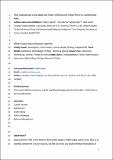Files in this item
Assessing bait use by static gear fishers of the Scottish Inshore fisheries : a preliminary study
Item metadata
| dc.contributor.author | Spoors, Felicity | |
| dc.contributor.author | Mendo, Tania | |
| dc.contributor.author | Khan, Nicola | |
| dc.contributor.author | James, Mark | |
| dc.date.accessioned | 2022-04-18T23:42:58Z | |
| dc.date.available | 2022-04-18T23:42:58Z | |
| dc.date.issued | 2021-08 | |
| dc.identifier | 273886308 | |
| dc.identifier | b5d1269f-8023-484b-89c6-dbd48a7fb64d | |
| dc.identifier | 85104399451 | |
| dc.identifier | 000663332400007 | |
| dc.identifier.citation | Spoors , F , Mendo , T , Khan , N & James , M 2021 , ' Assessing bait use by static gear fishers of the Scottish Inshore fisheries : a preliminary study ' , Fisheries Research , vol. 240 , 105974 . https://doi.org/10.1016/j.fishres.2021.105974 | en |
| dc.identifier.issn | 0165-7836 | |
| dc.identifier.other | RIS: urn:A7E056BA51CE0B19BE3C807F32CA1B1B | |
| dc.identifier.other | ORCID: /0000-0002-7182-1725/work/92775301 | |
| dc.identifier.other | ORCID: /0000-0002-5547-9595/work/108119070 | |
| dc.identifier.other | ORCID: /0000-0003-4397-2064/work/148888374 | |
| dc.identifier.uri | https://hdl.handle.net/10023/25208 | |
| dc.description.abstract | Approximately 70 % of the Scottish fishing fleet target shellfish using baited creels. Bait is an essential component of catch success, but the economic and environmental implications of bait use are unknown. In this preliminary study, a short survey was circulated to members of the Scottish inshore creeling fleet and analysed alongside spatial data from 8 creel fishing vessels. Bait biomass, input into coastal waters through creeling activity, was calculated along with bait types, motivations surrounding the discarding of used bait and the annual estimated spatial concentration. Findings indicate that preferred bait types differ with geographic location and cost the creeling sector approximately £9.8 million annually at the time of the survey, equating to 16.3 % of the nominal 2018 shellfish landing value. Data from this research suggests that approximately 13,492 metric tonnes of bait biomass enters coastal Scottish waters through creeling activities annually. Vessel tracks showed fishers returning to certain fishing grounds repeatedly, indicating that bait biomass input is highly localised. Hotspots of fishing activity were calculated to receive up to 75 kg ha−1 and 47 kg ha−1 of bait biomass per fisher annually when fishing Nephrops and crab/ lobster, respectively. Bait discarding occurs most frequently at the fishing grounds with convenience being the main motivation. This study provides a baseline for future studies and prompts the consideration of bait use in the management of creel fisheries. | |
| dc.format.extent | 9 | |
| dc.format.extent | 497165 | |
| dc.language.iso | eng | |
| dc.relation.ispartof | Fisheries Research | en |
| dc.subject | Coastal fisheries | en |
| dc.subject | Bait biomass | en |
| dc.subject | Creel fishing | en |
| dc.subject | Fisher knowledge | en |
| dc.subject | Fisheries management | en |
| dc.subject | SH Aquaculture. Fisheries. Angling | en |
| dc.subject | 3rd-DAS | en |
| dc.subject | SDG 14 - Life Below Water | en |
| dc.subject.lcc | SH | en |
| dc.title | Assessing bait use by static gear fishers of the Scottish Inshore fisheries : a preliminary study | en |
| dc.type | Journal article | en |
| dc.contributor.institution | University of St Andrews. School of Biology | en |
| dc.contributor.institution | University of St Andrews. School of Geography & Sustainable Development | en |
| dc.contributor.institution | University of St Andrews. Coastal Resources Management Group | en |
| dc.contributor.institution | University of St Andrews. Scottish Oceans Institute | en |
| dc.contributor.institution | University of St Andrews. School of Psychology and Neuroscience | en |
| dc.contributor.institution | University of St Andrews. Marine Alliance for Science & Technology Scotland | en |
| dc.identifier.doi | 10.1016/j.fishres.2021.105974 | |
| dc.description.status | Peer reviewed | en |
| dc.date.embargoedUntil | 2022-04-19 | |
| dc.identifier.url | http://irep.ntu.ac.uk/id/eprint/44226 | en |
This item appears in the following Collection(s)
Items in the St Andrews Research Repository are protected by copyright, with all rights reserved, unless otherwise indicated.

